Category Archives for Facial Features

How to Achieve Contrast in Facial Features Using Glazing Techniques
Unlock the power of glazing techniques to create stunning depth and realism in facial features
Creating lifelike contrast in facial features is an essential skill for any portrait artist, especially when working with acrylics. By using glazing techniques, you can add depth, refine shadows, and bring out details that elevate the realism of your paintings. This guide will walk you through how to use glazing to create dynamic contrasts in the facial features, ensuring your portraits are more vibrant and visually striking.
What is Glazing in Acrylic Painting?
Glazing is a technique that involves layering thin, transparent layers of paint over a dry underpainting. This allows you to build up rich tones and fine details without altering the structure of the layers beneath. By adjusting the intensity of the glaze, you can manipulate the contrast between light and dark areas of your painting.
Why Contrast Matters in Portraits
Contrast is key to achieving a realistic portrait. It’s the difference between the lightest and darkest areas that define the contours and features of the face. Without strong contrast, the face can appear flat and lifeless. Glazing techniques allow artists to enhance this contrast gradually, creating a more three-dimensional look.
Steps to Achieve Contrast in Facial Features Using Glazing
1. Prepare Your Base Layer
Start by creating a well-defined underpainting with an appropriate mid-tone value. This will serve as the foundation for your glazes. Make sure this layer is fully dry before you begin applying any glazes.
2. Apply Initial Glaze to Dark Areas
Begin with your darkest areas, such as the hairline, eyebrows, and shadows around the eyes. Mix a transparent layer of paint using a dark color like raw umber or burnt sienna. Add a glazing medium to make the paint transparent and apply it over the underpainting.
3. Refining Facial Features
For the nose, chin, and cheekbones, observe the natural contours and apply glazes to enhance the depth. Focus on adding subtle shadow variations by layering transparent colors. These will blend with the underpainting, creating a smooth transition from light to dark.
4. Layering to Increase Contrast
Once your first glaze is dry, apply subsequent layers to build up more contrast. Use lighter glazes for areas like the forehead, tip of the nose, and under the eyes. A combination of titanium white and yellow ochre can be used for highlights. This gradual layering process allows the colors to meld seamlessly, creating a rich contrast.
5. Detailing with Fine Glazes
For fine details like the texture of the skin, eyelids, and lips, you can use a more delicate glaze. Use a fine-tipped brush to add lighter tones on the skin’s surface or a darker glaze to intensify shadows around the jawline or under the nose. The key is to maintain a balance between light and dark to keep the face looking natural.
6. Final Refinements
After several layers, evaluate your painting to see if additional contrast is needed. Add glazes to areas where shadows may need to be deepened or highlights need to be accentuated. Blend the glazes smoothly to avoid harsh lines and ensure that all features have a harmonious depth.
Tips and Techniques for Perfecting Contrast with Glazing
- Use a Slow-Drying Medium: A slow drying medium allows you more time to manipulate your glazes before they set. This can be particularly helpful for blending.
- Thin Layers are Key: Thin, transparent layers allow the underlying colors to show through, giving your portrait more dimension. Avoid thick, opaque layers as they can overpower the underpainting.
- Pay Attention to Light Source: Always keep the light source in mind. Shadows will fall in different places depending on the position of the light. This will determine where you apply your darker glazes.
- Use Complementary Colors for Contrast: Using complementary colors, like mixing greens with reds or blues with oranges, can create dynamic contrast, making your facial features pop.
Common Mistakes to Avoid
- Over-applying Glaze: Too many glazes can obscure the fine details of your portrait. Be patient and build layers gradually.
- Not Allowing Layers to Dry: Glaze should always be applied to a dry layer to avoid muddiness. Always allow each layer to fully dry before adding another glaze.
- Not Using Enough Contrast: It’s easy to understate contrast in portraits, especially when using glazes. Make sure your darkest darks and lightest lights are well represented.
Achieving contrast in facial features using glazing techniques is an essential skill that can bring your acrylic portraits to life. By applying thin layers of transparent paint, you can build up depth, highlight details, and enhance the three-dimensionality of your subject. With patience and careful attention to light and shadow, you can master this technique and elevate your portrait painting to new levels of realism.
Remember, contrast is about balance too little, and your painting will look flat; too much, and it can appear harsh. With glazing, you have the perfect tool to control this balance, creating a beautifully nuanced and realistic portrait.
If you’re looking for more instructional videos on how to improve your acrylic painting, visit www.realisticacrylic.com for more tutorials and check out my free courses here.
Frequently Asked Questions (FAQ)
Q: How many layers of glaze should I apply?
A: The number of layers depends on the depth you want to achieve. Typically, three to five layers work well for creating noticeable contrast.
Q: Can I use glazing on all parts of the face?
A: Yes, glazing can be applied to all parts of the face, including the eyes, nose, lips, and hair. It’s especially effective for adding depth to areas like the eye sockets and the jawline.
Q: What type of glaze medium is best for portraits?
A: An acrylic glazing medium is best for portraits, as it allows for smooth application and transparency. Avoid using heavy mediums that may make the paint too thick.
Q: Do I need to use dark glazes for shadows?
A: Dark glazes work well for deep shadows, but you can also use mid-tones or neutral colors. The goal is to create a gradual transition from light to dark, not to create harsh, artificial shadows.
Tips for Achieving Contrast in Facial Features:
- Apply thin layers of glazes to gradually build depth.
- Focus on the light source to guide your application of glazes.
- Experiment with complementary colors for stronger contrast.
- Allow each glaze layer to dry before adding another for smooth blending.
LEARN MORE
- Sketching Your Painting Accurately
- Beginning a Pet Portrait in Acrylic
- The Mystery of Realism in Painting
- Apply A Burnt Sienna Glaze to a Portrait
- Learn How to Sketch a Portrait Freehand in 45 Minutes
- Adding highlights to your acrylic painting
- 5 Excellent Reasons to Use Aluminum Foil
- Paint Realistic Wrinkles in Acrylic
- Painting Clothing in an Acrylic Portrait
- Paint a Cloudy Sky Acrylic
- How to add Semi-Opaque Highlights
- How to Enhance the Contrast in Your Acrylic
- How to Add Glaze to Your Acrylic Painting
- Paint Realistic Reflections on Eyeglasses in an Acrylic Portrait
- Build Up Depth on Your Acrylic Portrait Backgrounds
- How Do You Do Layers With the Glazing Technique?
- Learn How to Paint Wrinkles in Acrylic
Read more about how to paint a portrait that you can surely be proud of!
I’d love to hear your thoughts on this video. Please share it with your friends and family. Let me know if you have any further questions. I’ll greatly help you.
If you’d like to learn more, sign up for my free email tips and video class today.
Learn How to Paint Acrylic Portraits With My Free Mini-Video Course!Thank you so much for taking the time to read this tutorial and watch the video. That means a lot to me. I hope you find it very helpful in your portrait painting.
Yours for Better Portraits,

P.S. Did you find this post helpful or encouraging? If so, send it in ahead! Let others know with the share buttons below. I’d love to hear your comments. Thank you so much! Also, do you have a question on acrylic portrait painting you’d like answered? Let me know, and I’d be happy to help!

How To Paint Lips In Acrylic Portrait: 7 Steps
Detailed guide to creating realistic lips in your acrylic paintings
Introduction
Painting lips in an acrylic portrait is a delicate and crucial step in achieving a realistic and expressive face. The lips are not only central to the facial features but also convey emotions and character. In this guide, we’ll walk you through a detailed process of painting lips, focusing on blending, shading, and adding those subtle highlights that bring the lips to life.
Understanding the Structure of Lips
Before diving into the painting process, it’s essential to understand the anatomy of lips. The lips consist of various shapes, curves, and subtle color variations. The upper lip is usually thinner and has a more defined curve, while the lower lip is fuller and catches more light. The area where the lips meet is typically darker, creating a natural shadow.
Step-by-Step Guide to Painting Lips
1. Initial Shadowing
- Begin by adding a shadow on the side of the nose that faces away from the light. Use a mixture of raw umber dark, raw sienna, and a bit of titanium white. This shadow will help in defining the nasolabial fold and the overall shape of the lips.
- Thin out the glaze to blend it smoothly into the surrounding skin tone, creating a natural transition.
2. Defining the Lip Shape
- Move on to the lips by refining the edges and shape. Mix titanium white, pyrrole red orange, and raw umber dark to create a base color for the lips.
- Apply this mixture to the lips, focusing on smoothing out the values, especially on the darker side of the lips. Gradually lighten the color as you move towards the apex of the lips, where the light hits.
3. Blending and Smoothing
- Add raw sienna to the mixture to warm up the edges of the lips. This helps in creating a realistic transition between the lips and the surrounding skin.
- Keep your paint fluid by thinning it with water or matte medium, allowing for smooth blending without harsh lines.
4. Enhancing the Lip Contour
- Use a combination of raw umber dark, alizarine crimson, and ultramarine blue to create a darker tone for the interior creases of the lips. This will add depth and dimension to the lips, making them appear more three-dimensional.
- Apply these darker tones to the creases and areas where the lips naturally fold or wrinkle. This step is crucial for capturing the texture and realism of the lips.
5. Adding Highlights
- Introduce a bit of titanium white and pyrrole red orange to the mix for the highlights. Focus on the upper part of the lower lip and the center of the upper lip, where the light naturally hits.
- These highlights should be subtle, blending smoothly into the surrounding colors. The key is to create a soft transition that enhances the curvature of the lips without making the highlights appear too harsh or artificial.
6. Final Touches
- Add final touches by refining the shape and edges of the lips. Use a fine brush to capture the small creases and details that give the lips their unique texture.
- Incorporate a slight amount of ultramarine blue and raw umber dark to the bottom edge of the lips for added depth. This creates a shadow that helps the lips stand out from the surrounding skin.
7. Developing the Surrounding Area
- Remember to consider the areas surrounding the lips as well. Shadows beneath the lower lip and slight highlights on the upper lip area can add to the realism of the portrait.
- Use a diluted mix of the darker tones to add subtle shadows and enhance the depth of the lips.
Tips and Techniques for Painting Lips
- Keep Your Paint Fluid: Thin your paint with water or matte medium to achieve smooth transitions and avoid harsh edges.
- Focus on Light and Shadow: Pay attention to the light source in your painting. The lips should have a natural gradient, with the lightest areas being where the light hits directly.
- Use a Variety of Colors: Lips are not just red or pink; they have a range of colors, including subtle blues, purples, and browns. Experiment with different tones to achieve a more realistic effect.
- Build Layers Gradually: Start with thin layers of paint and gradually build up the color and texture. This approach allows for more control and a more natural appearance.
- Refine Details: Use fine brushes to add small creases, highlights, and shadows that give the lips their unique character. These details make a significant difference in the overall realism of the portrait.
Painting lips in an acrylic portrait requires patience, attention to detail, and an understanding of the subtle nuances that make up this important facial feature. By following this step-by-step guide, you can achieve realistic and expressive lips that enhance the overall impact of your portrait. Remember, practice makes perfect, so keep experimenting with different techniques and colors to refine your skills.
To learn more, watch my free video tutorial on how to paint lips in your acrylic.
- Sketching Your Painting Accurately
- Beginning a Pet Portrait in Acrylic
- The Mystery of Realism in Painting
- Apply A Burnt Sienna Glaze to a Portrait
- Learn How to Sketch a Portrait Freehand in 45 Minutes
- Adding highlights to your acrylic painting
- 5 Excellent Reasons to Use Aluminum Foil
- Paint Realistic Wrinkles in Acrylic
- Painting Clothing in an Acrylic Portrait
- Paint a Cloudy Sky Acrylic
- How to add Semi-Opaque Highlights
- How to Enhance the Contrast in Your Acrylic
- How to Add Glaze to Your Acrylic Painting
- Paint Realistic Reflections on Eyeglasses in an Acrylic Portrait
- Build Up Depth on Your Acrylic Portrait Backgrounds
- How Do You Do Layers With the Glazing Technique?
- Learn How to Paint Wrinkles in Acrylic
Read more about how to paint a portrait that you can surely be proud of!
I’d love to hear your thoughts on this video. Please share it with your friends and family. Let me know if you have any further questions. I’ll greatly help you.
If you’d like to learn more, sign up for my free email tips and video class today.
Learn How to Paint Acrylic Portraits With My Free Mini-Video Course!
Thank you so much for taking the time to read this tutorial and watch the video. That means a lot to me. I hope you find it very helpful in your portrait painting.
Yours for Better Portraits,

P.S. Did you find this post helpful or encouraging? If so, send it in ahead! Let others know with the share buttons below. I’d love to hear your comments. Thank you so much! Also, do you have a question on acrylic portrait painting you’d like answered? Let me know, and I’d be happy to help!
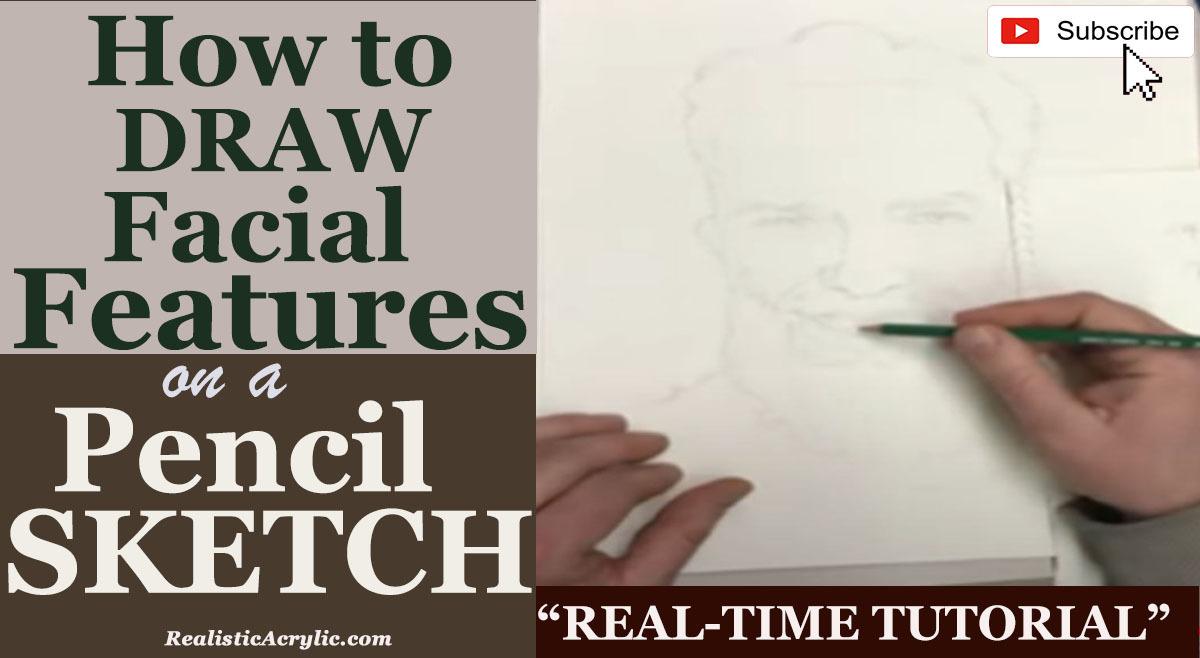
How to Draw Facial Features in Pencil Sketch
Learn how to draw realistic facial features with pencil sketch techniques—Tips for perfecting eyes, nose, lips, and more.
Drawing realistic facial features in a pencil sketch requires attention to detail, patience, and a clear understanding of proportion and shading. Whether you’re working on a self-portrait or creating a likeness of someone else, refining key elements such as the eyes, nose, and lips is essential to achieving a lifelike representation. In this guide, we will walk you through the process of drawing facial features with a focus on capturing the unique characteristics of each part of the face.
Getting Started with Basic Outlines
In the initial phase of drawing, it is important to loosely block in the outlines of the facial features. This helps establish the general proportions and placement of the eyes, nose, mouth, and other elements. A 2H pencil is recommended for these initial light strokes since it produces faint lines that are easier to adjust as needed.
- Grid Method: Using a grid is a helpful tool to maintain the correct proportions and ensure that facial features are aligned accurately. Lightly sketch the outlines of the eyes, nose, lips, and overall head shape using the grid as a guide.
- Basic Shapes: The eyes are often drawn as almond shapes or football-like structures, but it’s essential to avoid making them overly stylized or cartoony. Each person’s eyes differ in size and shape based on their eyelids and other factors.
Drawing the Eyes
Eyes are arguably the most important feature when it comes to capturing expression and realism in a portrait. The goal is to draw them in a way that reflects their actual appearance rather than relying on preconceived ideas of how eyes look.
- Shape of the Iris and Pupil: Start by drawing the iris, the round part of the eye. It’s common for beginners to make the iris appear too flat or symmetrical, but this doesn’t account for natural variations in eye shape. The pupil is drawn in the center of the iris but with care taken to ensure it looks natural.
- Upper Eyelid and Fold: The upper eyelid often casts a shadow over the iris, creating depth in the eye. Add the crease or fold above the eyelid if applicable—this fold is more prominent in some people and less so in others. Remember, eyes appear squintier in some angles, so adjust based on your reference.
- Reflection in the Eye: A small highlight or reflection is usually seen on the surface of the eye, which should be placed carefully. This reflection comes from light sources in the environment and adds a realistic touch.
- Adding Eyelashes and Eyebrows: Be subtle when drawing the eyelashes—overdoing it can make the portrait look exaggerated. For eyebrows, use soft, feathered strokes to simulate the hair texture, paying attention to the density and shape.
Refining the Nose
The nose can be tricky due to its three-dimensional structure, but using shading can greatly assist in creating depth and realism.
- Nostril Shape: Focus on drawing the correct nostril shapes without making them too bold. The nostrils should not be drawn as harsh, circular outlines but rather suggested through soft shading and curvature.
- Shading and Contours: The nose has subtle curves and contours that require delicate shading. The areas around the nose bridge and the sides should be shaded to indicate depth. Pay close attention to the light source, as it will dictate where shadows fall.
Drawing the Mouth and Teeth
The mouth, especially the lips, can define the emotion and personality of the subject.
- Shape of the Lips: When drawing the lips, focus on the shape and volume of both the upper and lower lips. The upper lip typically has a more defined curve, while the bottom lip is fuller. The key is to use shading to indicate the volume rather than relying on harsh outlines.
- Teeth Placement: When drawing teeth, avoid drawing each tooth with equal emphasis. The front two teeth are generally more prominent, while the side teeth appear smaller due to perspective. Pay attention to how the teeth curve in the mouth, as they are never viewed head-on in a natural smile.
- Creases and Shadows: The small crevices or gaps between the teeth and lips, as well as the shadow under the bottom lip, are essential for a realistic representation. These areas should be subtly shaded to create depth and natural transitions between features.
Adding Final Details and Shading
At this stage, your portrait will have all the major features sketched out. Now, it’s time to refine the details and add depth through shading.
- Refining the Eyes: Darken the pupil slightly while maintaining the reflection highlight. Add more definition to the iris by shading its outer edges lightly.
- Highlighting with Erasers: Use a kneaded eraser to pick out highlights, especially on the cheekbones, tip of the nose, and the top of the upper lip. This helps to bring out the areas that naturally catch more light.
- Blending for Smooth Transitions: Use a blending stump or tissue to soften harsh lines and blend shading smoothly across the face. This helps create a realistic, three-dimensional effect, especially around curved areas like the cheeks and forehead.
- Layering Shading: Build up the depth of the sketch by gradually darkening certain areas, such as the eyes, nostrils, and under the chin. Shading should be applied in layers rather than all at once to give more control over the darkness and contrast.
Tips and Techniques for a Realistic Pencil Sketch
- Use Reference Photos: Always refer back to your subject or a reference image, as it’s easy to fall into drawing features as you think they look rather than how they truly appear.
- Be Patient with Details: Taking the time to refine small details, such as the reflections in the eyes or the shadows around the nose, can make a significant difference in the overall realism of your drawing.
- Avoid Over-Shading: While shading adds depth, too much shading can flatten the image or create unnecessary contrast. Subtle transitions between light and dark areas are key.
- Stay Loose in the Early Stages: Keep your lines loose and light during the blocking stage. It’s easier to adjust proportions and correct mistakes if the initial lines are not too bold.
- Use the Grid Method: If you’re struggling with proportions, a grid can help break down the facial features into smaller, manageable sections, making it easier to replicate accurately.
By following these steps and techniques, you will be well on your way to creating a lifelike and expressive pencil sketch portrait. Remember, practice is essential, and over time, you’ll improve your ability to capture the subtle details that make each face unique.
If you’re looking for more instructional videos on how to improve your acrylic painting, visit www.realisticacrylic.com for more tutorials and check out my free courses here. . Happy painting.
- Adding highlights to your acrylic painting
- 5 Excellent Reasons to Use Aluminum Foil
- Paint Realistic Wrinkles in Acrylic
- Painting Clothing in an Acrylic Portrait
- Paint a Cloudy Sky Acrylic
- How to add Semi-Opaque Highlights
- How to Enhance the Contrast in Your Acrylic
- How to Add Glaze to Your Acrylic Painting
- Paint Realistic Reflections on Eyeglasses in an Acrylic Portrait
- Build Up Depth on Your Acrylic Portrait Backgrounds
- How Do You Do Layers With the Glazing Technique?
- Learn How to Paint Wrinkles in Acrylic
Read more about how to paint a portrait that you can surely be proud of!
I’d love to hear your thoughts on this video. Please share it with your friends and family. Let me know if you have any further questions. I’ll greatly help you.
If you’d like to learn more, sign up for my free email tips and video class today.
Learn How to Paint Acrylic Portraits With My Free Mini-Video Course!
Thank you so much for taking the time to read this tutorial and watch the video. That means a lot to me. I hope you find it very helpful in your portrait painting.
Yours for Better Portraits,

P.S. Did you find this post helpful or encouraging? If so, send it on ahead! Let others know with the share buttons below. I’d love to hear your comments. Thank you so much! Also, do you have a question on acrylic portrait painting you’d like answered? Let me know, and I’d be happy to help!
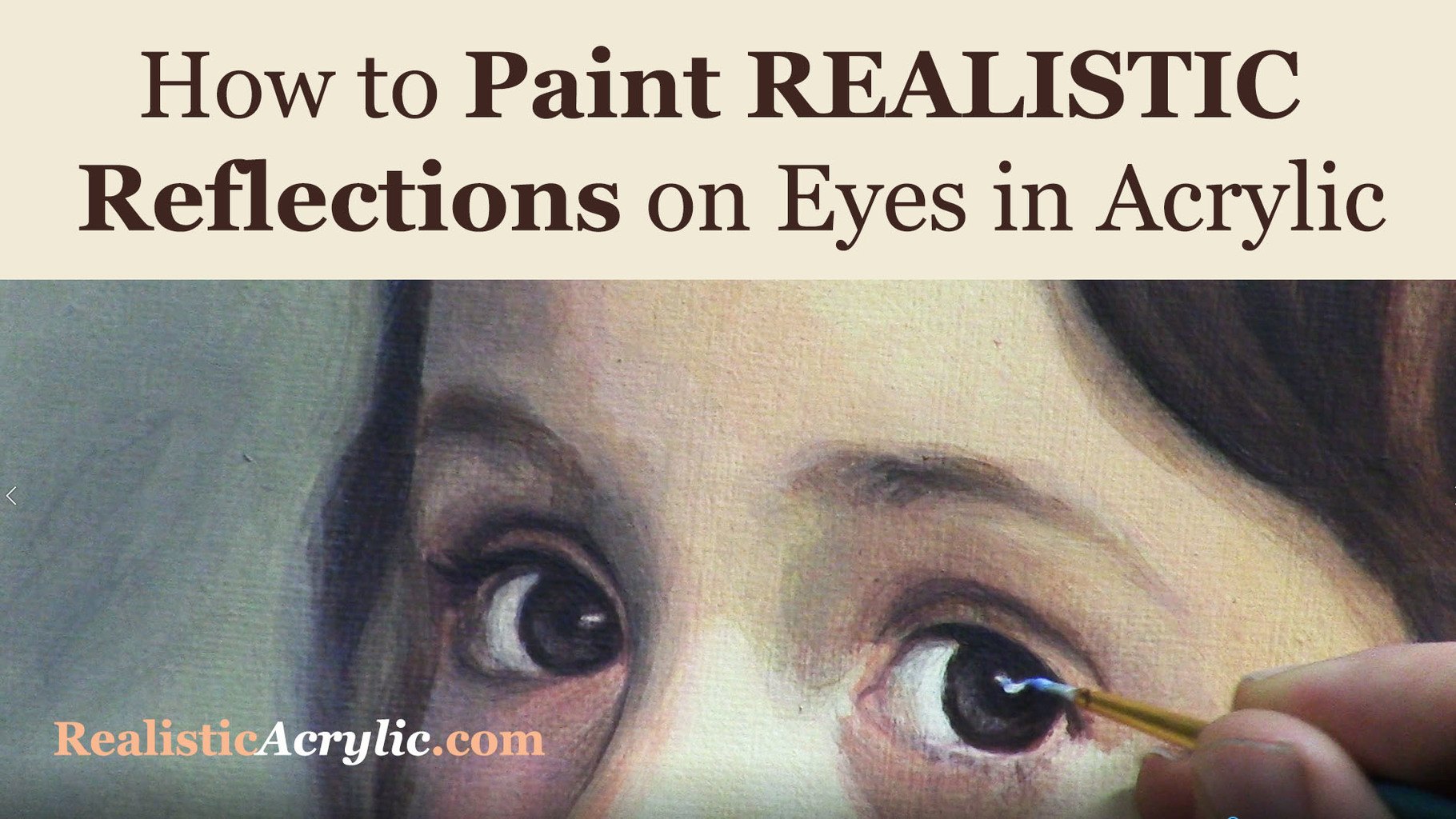
How to Paint Realistic Reflections on Eyes in Your Acrylic Portrait
Eyes are the most important feature of an acrylic portrait. When you paint the eyes correctly, everything else seems to fall into place so much easier.
In this video, I’ll show you how to paint realistic reflections, using two complementary colors in addition to white, and getting the shape of the reflection just right. Then this originally was a BONUS video in the Acrylic Portrait Painting Challenge Master Class, now available in the All-Access Membership at Realistic Acrylic Portrait School.
Even though it is technically over, you can take the Acrylic Portrait Painting Challenge (it’s FREE!) and paint along with us! 8 master class lessons are posted to help you paint a portrait you can be proud of!
REGISTER TODAY. The challenge is ongoing, something you can do at your own pace. It’s not too late to enter! After you join, I’ll send you the supplies list and reference photos to paint from.
Register for the Challenge!WATCH NOW…
Lesson #8: How to Paint Realistic Reflections on Eyes in Acrylic
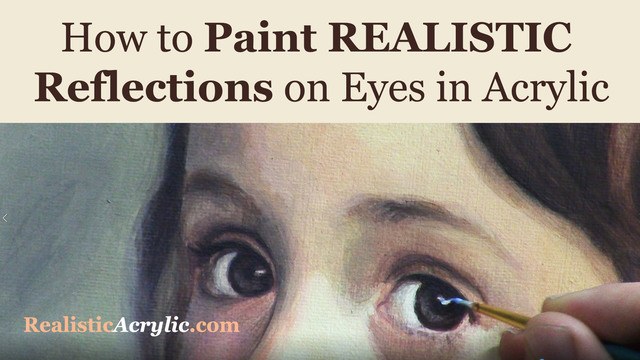
Questions? Suggestions? Thoughts? Let me know, below in the comments. Please share your sketches in our Facebook group and share this post with your friends!
- How to Paint Foliage Using the Acrylic Glazing Technique
- How to Trace for an Accurate Portrait Sketch
- How to Paint Realistic Eyes in Your Acrylic Portrait
- How to Add Raw Umber Dark & Ultramarine Blue to Your Portrait
- How to Make Your Own Raw Umber Dark
- How to Paint Realistic Trees & Grass in Your Acrylic
- How to Block In Skin Tone Values Using Glazing Technique
- How to Paint Vibrant Reds in Your Acrylic Portrait
- How to Glaze Background Colors & More Acrylic Portrait
- How to Paint White Clothing in Your Acrylic Portrait
- How to Easily Transition from a Sketch to a Painting
- How to Block In Shading & Skin Tones in Your Acrylic
- How to Build Up Color on Acrylic Pet Portrait
- How to Build Up Form on Clothing with Acrylic
- How to Paint Dark Clothing Using Acrylic Glazing Technique
- How to Paint a 24 x 30 Acrylic With 30 People
- How to Do Smooth Shading with Acrylic
- How to Sketch an Acrylic Portrait with a Grid
Read more about how to paint a portrait that you can surely be proud of!
I’d love to hear your thoughts about this video. Please share it with your friends and family. Let me know if you have any further questions. I’ll greatly help you.
Thank you so much for taking the time to read this tutorial and watch the video. That means a lot to me. I hope you find it very helpful in your portrait painting.

P.S. Did you find this post helpful or encouraging? If so, send it on ahead! Let others know with the share buttons below. I’d love to hear your comments. Thank you so much! Also, do you have a question on acrylic portrait painting you’d like answered? Let me know, and I’d be happy to help!
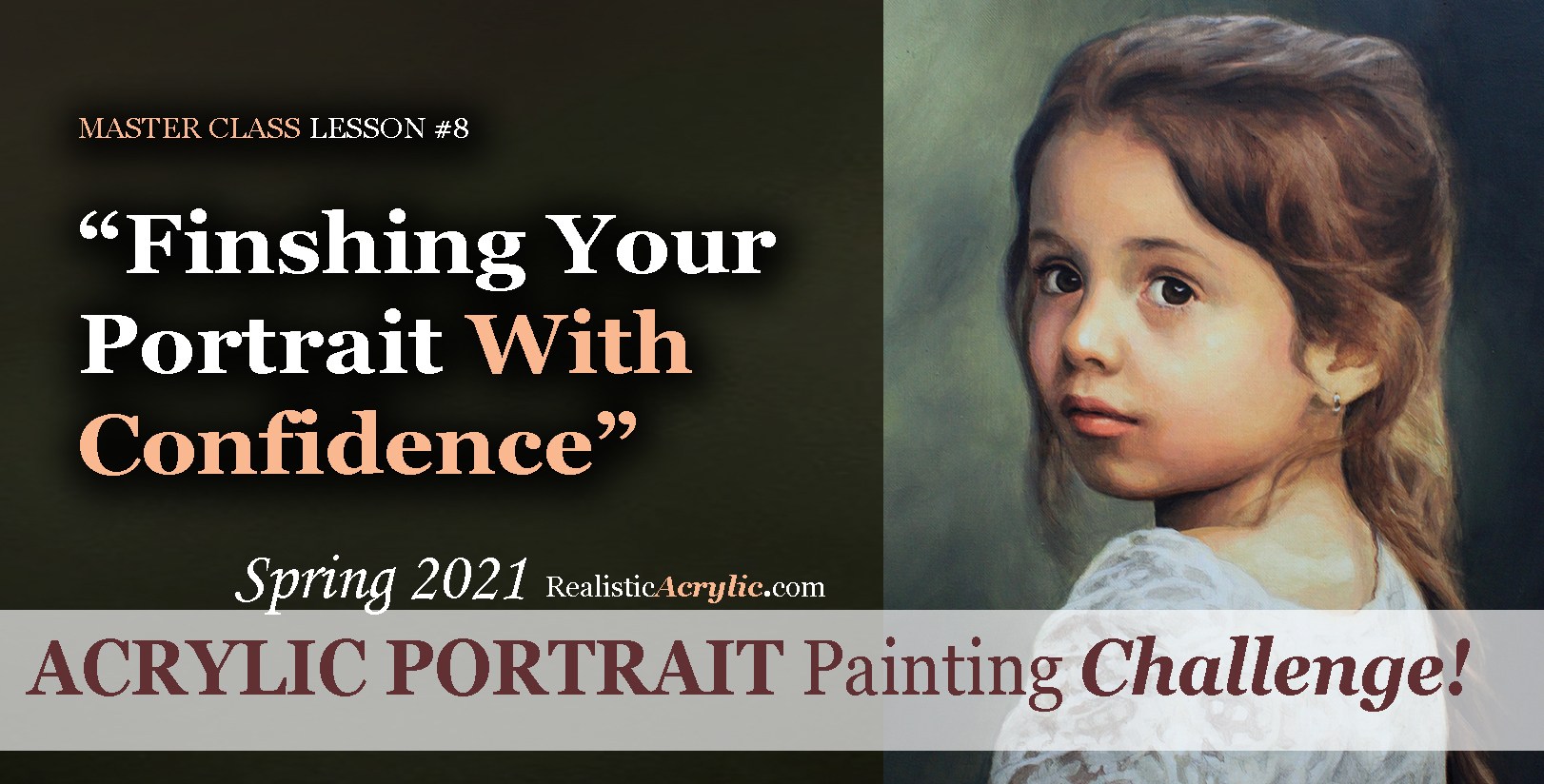
Spring 2021 Acrylic Portrait Painting Challenge: Finishing Your Portrait With Confidence
Let’s help you finish your painting!
In this lesson, we will be wrapping up the Masterclass series for the challenge! I’ll show you how to add some more nuances and details to the portrait of “Cora.” First, we’ll add a glaze to her hair to enrich the overall color. Next, we will enhance some nuances on her eyebrows, dial in the color of the eyes, and paint in the reflections. Finally, we’ll add in the skin tone for her arm in the lower corner and follow up with some work on her lace.
But even though we are nearly done with this portrait painting, it’s not too late to join in the fun!
YOU, too, can paint a portrait!
Take the Acrylic Portrait Painting Challenge (it’s FREE!) and paint along with us!
REGISTER TODAY. The challenge is ongoing, something you can do at your own pace. It’s not too late to enter! After you join, I’ll send you the supplies list and reference photos to paint from.
WATCH NOW…
Lesson #8: Finishing Your Portrait Confidently
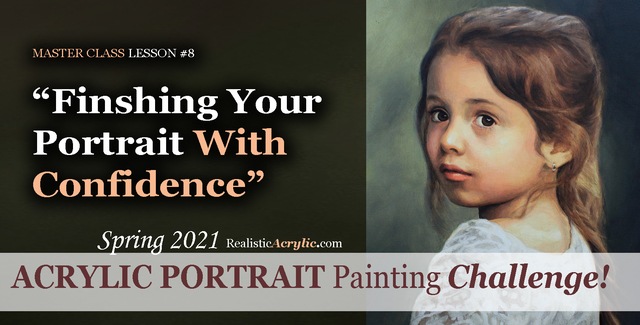
Professional artist and instructor Matt Philleo will teach you how to paint an acrylic portrait you can be proud of with this Portrait Painting Challenge!
Would like to paint this portrait with me and hundreds of other artists?
Take the 2021 Spring Portrait Painting Challenge!
You can register below and get started. It is completely FREE to join the challenge and participate. When you join, I’ll send you the “Welcome Kit” which includes:
- The Supplies List (so you know what you need to paint with us, your shopping list. 🙂 )
- The Reference Photo with and without the grid, high resolution, that you can download ready to print out or display on your tablet. You’ll be able to create an accurate portrait this way.
- The Palette Layout Guide showing you how to arrange your colors so they don’t get muddy on your palette
- The Master Class Lesson Schedule
- the Lessons emailed to you
- A private Facebook group to cheer you and help answer your questions
- And a few “bonuses” like opportunities to win my paid online classes
REGISTER TODAY. The challenge is ongoing, something you can do at your own pace. It’s not too late to enter!
Let me know if you have any questions and I look forward to teaching you more!
—Matt
Questions? Suggestions? Thoughts? Let me know, below in the comments. Please share your sketches in our Facebook group and share this post with your friends!
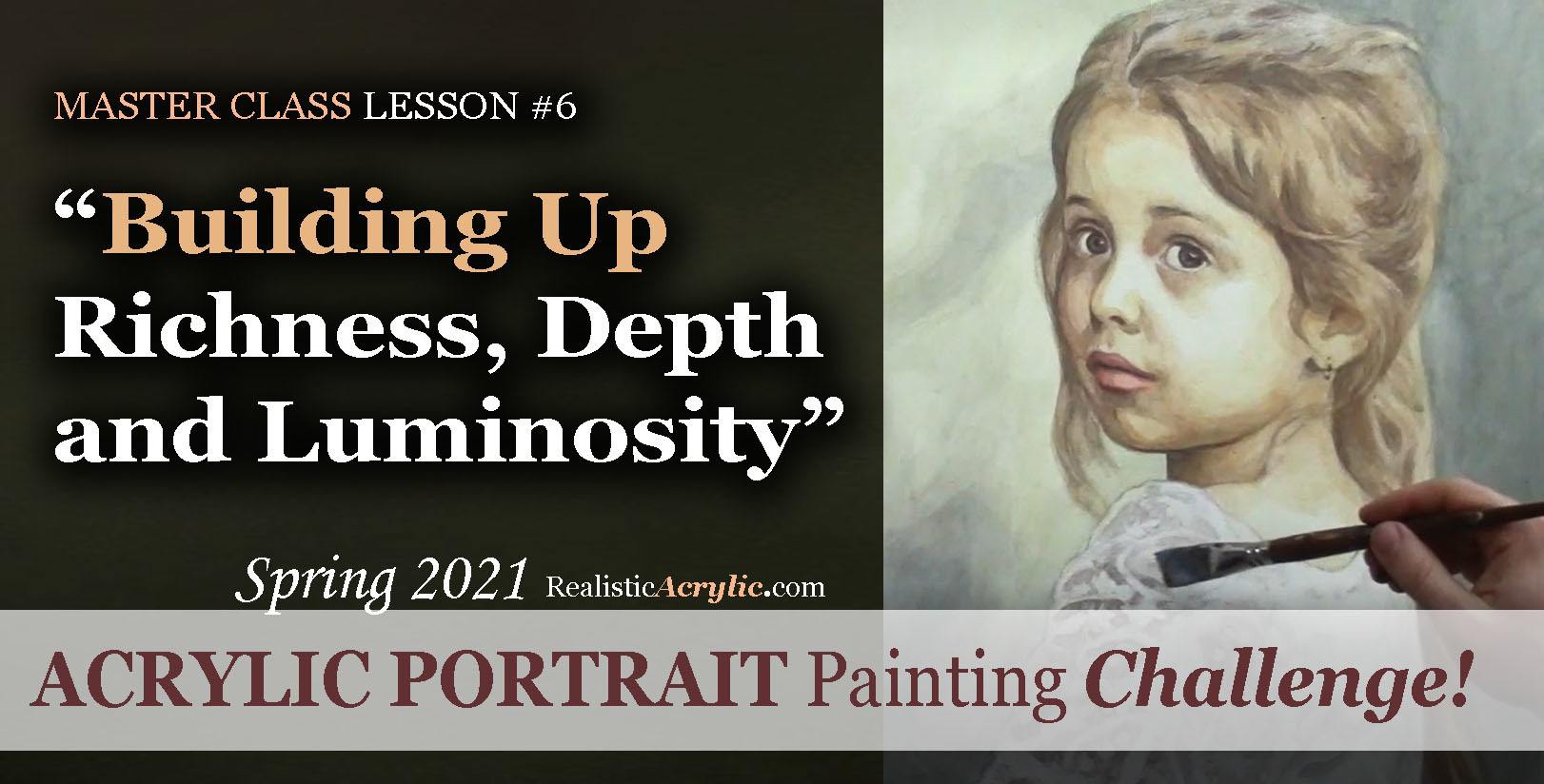
Spring 2021 Acrylic Portrait Painting Challenge: Painting Delicate Details and Nuances
After building the foundation with several layers of value, form, and color, we can then start to “dial in” the detail and nuances.
In this master class lesson (7 of 8), I’ll demonstrate how to add specific detail shapes to “Cora’s” hair. I’ll also add some additional shading to her forehead with a very translucent glaze. Next, I darken the left side of her face while smoothing out some of the rough application of previous glazes with a semi-opaque layer that’s cooler in tone. Finally, I add nuances to her eyes, lips and chin.
But even though we are well along in this portrait painting, it’s not too late to join in the fun!
YOU, too, can paint a portrait!
Take the Acrylic Portrait Painting Challenge (it’s FREE!) and paint along with us!
REGISTER TODAY. The challenge is ongoing, something you can do at your own pace. It’s not too late to enter! After you join, I’ll send you the supplies list and reference photos to paint from.
WATCH NOW…
Lesson #7: Painting Delicate Details and Nuances
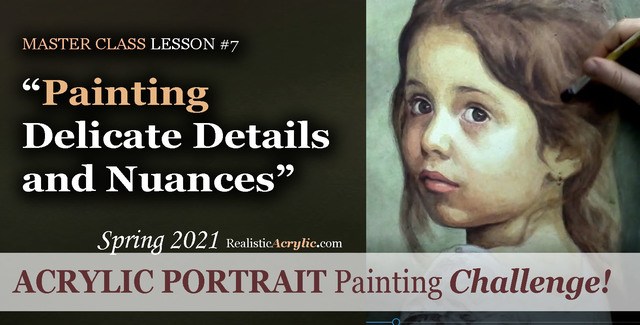
Learn how to do smooth shading, skin tones, details, and nuances in this FREE online portrait painting class by Matt Philleo at Realistic Acrylic Portrait School
Would like to paint this portrait with me and hundreds of other artists?
Take the 2021 Spring Portrait Painting Challenge!
You can register below and get started. It is completely FREE to join the challenge and participate. When you join, I’ll send you the “Welcome Kit” which includes:
- The Supplies List (so you know what you need to paint with us, your shopping list. 🙂 )
- The Reference Photo with and without the grid, high resolution, that you can download ready to print out or display on your tablet. You’ll be able to create an accurate portrait this way.
- The Palette Layout Guide showing you how to arrange your colors so they don’t get muddy on your palette
- The Master Class Lesson Schedule
- the Lessons emailed to you
- A private Facebook group to cheer you and help answer your questions
- And a few “bonuses” like opportunities to win my paid online classes
REGISTER TODAY. The challenge is ongoing, something you can do at your own pace. It’s not too late to enter!
Let me know if you have any questions and I look forward to teaching you more!
—Matt
Questions? Suggestions? Thoughts? Let me know, below in the comments. Please share your sketches in our Facebook group and share this post with your friends!

Spring 2021 Acrylic Portrait Painting Challenge: Building Up Richness, Depth and Luminosity
Acrylic is a fantastic medium for portrait painting, but it can be so challenging to use! That is why I am teaching you the glazing technique to open a lot of possibilities and ease your frustration.
Historically, the Old Masters used small amounts of pigment dispersed in larger amounts of linseed oil or mineral spirits to create a sense of volume and depth in their paintings. Light shines through and you can see a bit of each layer beneath the ones on top.
We can use that technique to our advantage with acrylic. By applying several translucent layers, there is an increased sense of depth, shading, contrast and color saturation and luminosity.
In this particular lesson, I’ll demonstrate how to add richness to the mid-tones of the girl’s face and hair. We will also add more contrast to the image with a couple of layers to the background, and turn the form of her figure with a precisely placed glaze on her clothing.
But even though we are well along in this portrait painting, it’s not too late to join in the fun!
Take the Acrylic Portrait Painting Challenge (it’s FREE!) and paint along with us!
REGISTER TODAY. The challenge is ongoing, something you can do at your own pace. It’s not too late to enter! After you join, I’ll send you the supplies list and reference photos to paint from.
WATCH NOW…
Lesson #6: Building Up Richness, Depth, and Luminosity

Learn how to create a vibrant acrylic portrait where the colors are not flat or muddy. In this FREE step by step master class, I’ll show you how!
Would like to paint this portrait with me and hundreds of other artists?
Take the 2021 Spring Portrait Painting Challenge!
You can register below and get started. It is completely FREE to join the challenge and participate. When you join, I’ll send you the “Welcome Kit” which includes:
- The Supplies List (so you know what you need to paint with us, your shopping list. 🙂 )
- The Reference Photo with and without the grid, high resolution, that you can download ready to print out or display on your tablet. You’ll be able to create an accurate portrait this way.
- The Palette Layout Guide showing you how to arrange your colors so they don’t get muddy on your palette
- The Master Class Lesson Schedule
- the Lessons emailed to you
- A private Facebook group to cheer you and help answer your questions
- And a few “bonuses” like opportunities to win my paid online classes
REGISTER TODAY. The challenge is ongoing, something you can do at your own pace. It’s not too late to enter!
Let me know if you have any questions and I look forward to teaching you more!
—Matt
Questions? Suggestions? Thoughts? Let me know, below in the comments. Please share your sketches in our Facebook group and share this post with your friends!

Spring 2021 Acrylic Portrait Painting Challenge: Sculpting Shading and Skin Tones in Your Acrylic Portrait
Acrylic portrait painting, in many ways, is like creating a sculpture. We want to truly make our faces look realistic and three-dimensional. In this master class video lesson, I show you how to do exactly that.
We’re breaking a fine art portrait painting down into bite-size steps that YOU can do.
Specifically, in this video lesson, I demonstrate how darkening your background can really make the face stand out in a lifelike way.
What colors should we use for the shadows? I’ll show you how to mix them, what brushes to use to apply them, and HOW to do it. Get the shadows right, and 80% of the battle is won, so to speak in your portrait.
What colors for the skin tones?
In this video, you’ll learn the correct color to mix, how to create glazes with matte medium and apply it to the face smoothly.
This is still very much the beginning. More lessons to come.
Take the Acrylic Portrait Painting Challenge (it’s FREE!) and paint along with us!
REGISTER TODAY. The challenge is ongoing, something you can do at your own pace. It’s not too late to enter! After you join, I’ll send you the supplies list and reference photos to paint from.
WATCH NOW…
Lesson #5: Sculpting Shading and Skin Tones in Your Acrylic Portrait
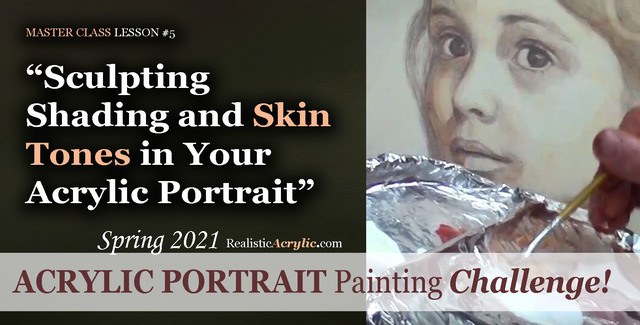
Acrylic Portrait Painting Challenge Lesson #5: Sculpting Shading and Skin Tones in Your Acrylic Portrait
Would like to paint this portrait with me and hundreds of other artists?
Take the 2021 Spring Portrait Painting Challenge!
You can register below and get started. It is completely FREE to join the challenge and participate. When you join, I’ll send you the “Welcome Kit” which includes:
- The Supplies List (so you know what you need to paint with us, your shopping list. 🙂 )
- The Reference Photo with and without the grid, high resolution, that you can download ready to print out or display on your tablet. You’ll be able to create an accurate portrait this way.
- The Palette Layout Guide showing you how to arrange your colors so they don’t get muddy on your palette
- The Master Class Lesson Schedule
- the Lessons emailed to you
- A private Facebook group to cheer you and help answer your questions
- And a few “bonuses” like opportunities to win my paid online classes
REGISTER TODAY. The challenge is ongoing, something you can do at your own pace. It’s not too late to enter!
What’s coming up in the next lesson? More shading, more skin tones, and the start of some detail work. Follow the lessons and you will be able to create a portrait you can be proud of…even if you’re a complete beginner!
Let me know if you have any questions and I look forward to teaching you more!
—Matt
Questions? Suggestions? Thoughts? Let me know, below in the comments. Please share your sketches in our Facebook group and share this post with your friends!

Spring 2021 Acrylic Portrait Painting Challenge: The Slow and Steady Way to Paint an Acrylic Portrait
If you remember the childhood story, “The Tortoise and the Hare,” you recall that the hare started out really fast and put the tortoise to shame. But then the rabbit took a nap, while the slow, while the turtle, with his slow methodical steps, passed him up and won the race!
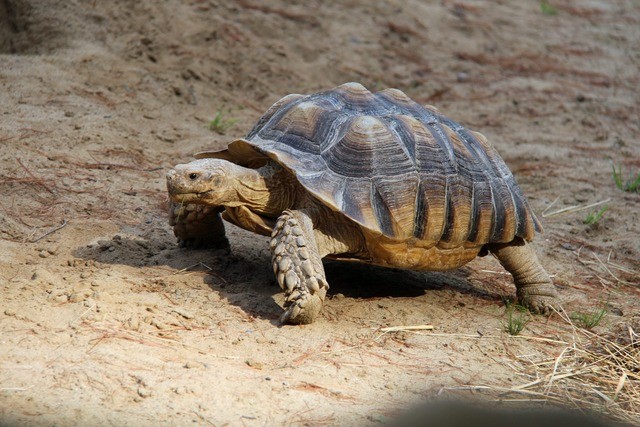
Sometimes slow is better for painting an acrylic portrait.
Likewise, in an acrylic portrait, we often want to see quick results. But if we take our time, and just add one layer on top of another, even though it looks like hardly anything is happening, eventually, we will end up with a great painting!
I’d like to show you how to slow down a bit, take your time, and paint your acrylic portrait layer by layer, using the acrylic glazing technique.
Take the Acrylic Portrait Painting Challenge (it’s FREE!) and paint along with us!
REGISTER TODAY. The challenge is ongoing, something you can do at your own pace. It’s not too late to enter! After you join, I’ll send you the supplies list and reference photos to paint from.
WATCH NOW…
Lesson #4: The Slow and Steady Way to Paint an Acrylic Portrait
In this master class lesson #4, I demonstrate how to continue darkening your darkest values on the face and background, and then work in some warmer glazes to set up the skin tones on her face. We’re going very light, using a large amount of matte medium (95%) to a small amount of paint (5%)
Watch how to do it here…
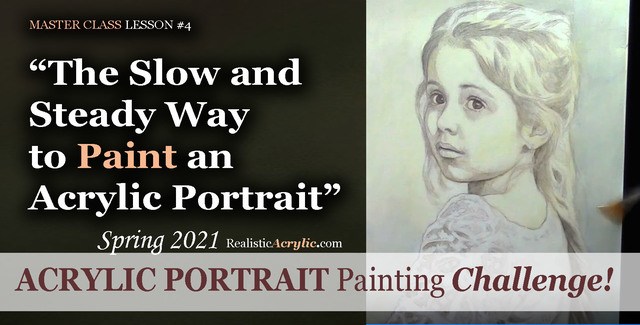
Learn how to paint an acrylic portrait slowly and correctly, step-by-step in this FREE master class lesson by Matt Philleo at Realistic Acrylic Portrait School!
Would like to paint this portrait with me and hundreds of other artists?
Take the 2021 Spring Portrait Painting Challenge!
You can register below and get started. It is completely FREE to join the challenge and participate. When you join, I’ll send you the “Welcome Kit” which includes:
- The Supplies List (so you know what you need to paint with us, your shopping list. 🙂 )
- The Reference Photo with and without the grid, high resolution, that you can download ready to print out or display on your tablet. You’ll be able to create an accurate portrait this way.
- The Palette Layout Guide showing you how to arrange your colors so they don’t get muddy on your palette
- The Master Class Lesson Schedule
- the Lessons emailed to you
- A private Facebook group to cheer you and help answer your questions
- And a few “bonuses” like opportunities to win my paid online classes
REGISTER TODAY. The challenge is ongoing, something you can do at your own pace. It’s not too late to enter!
Let me know if you have any questions and I look forward to teaching you more!
—Matt
Questions? Suggestions? Thoughts? Let me know, below in the comments. Please share your sketches in our Facebook group and share this post with your friends!
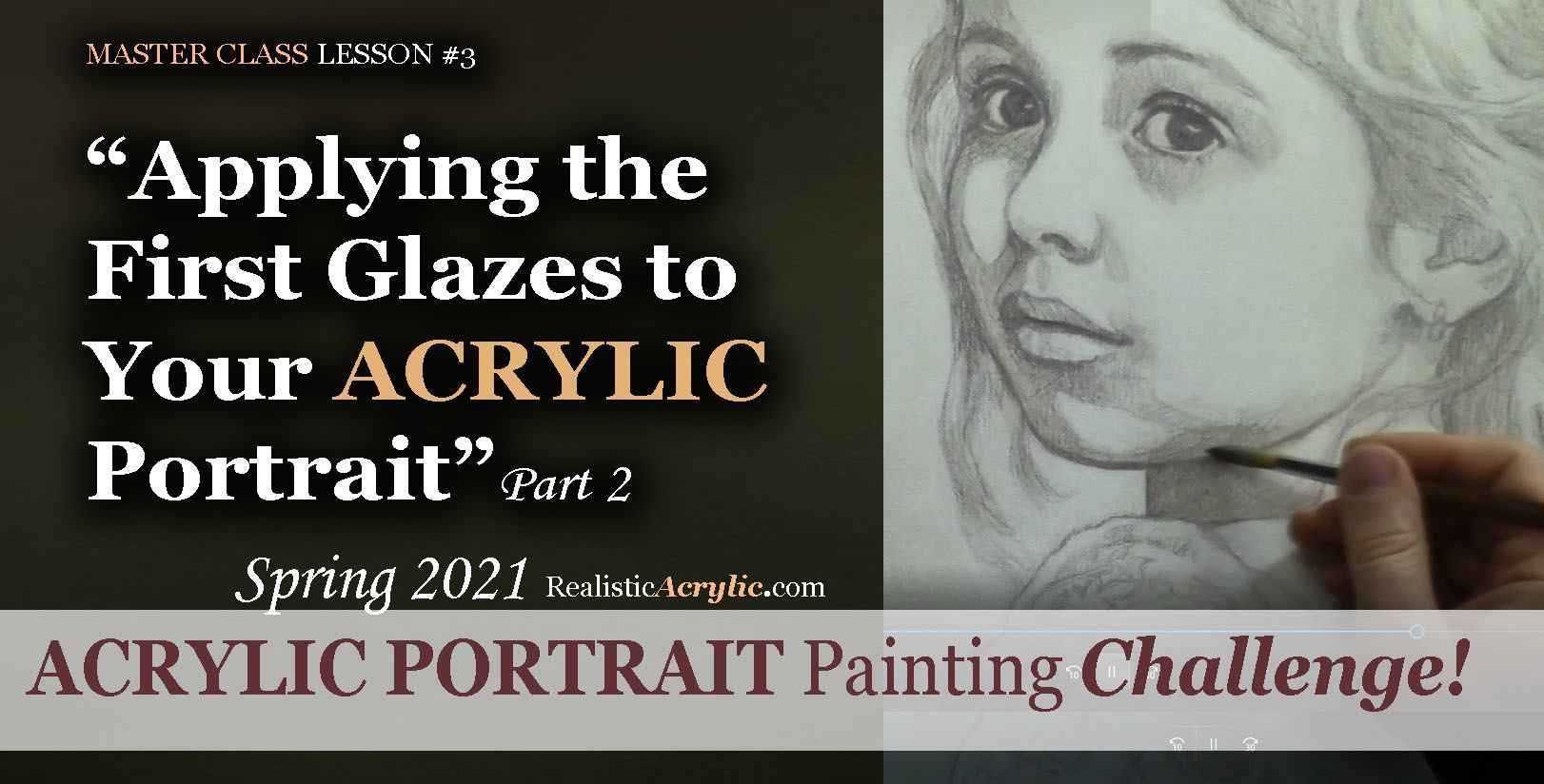
Spring 2021 Acrylic Portrait Painting Challenge: Applying Your First Glazes
Think of the acrylic glazing technique as a Polaroid camera print.
Remember those? You would load up the small film sheets, snap a picture and out popped the print. Back in those days (yes, I’m old enough to remember them) this was amazing. You wouldn’t have to drop off your film and wait 3 days (or even an hour!) for it to process.
But even then, it wasn’t immediate. The image would slowly fade in, and you’d watch a vague outline of your scene start to materialize. Finally, after a minute, you’d have a beautiful print!
In the same way, instead of painting our portrait one section at a time, with thick, opaque applications of paint, we slowly fade it in, covering the entire canvas at once, in stages. We use the classical acrylic glazing technique, just like Da Vinci, Titian and Vermeer used during the Renaissance to achieve smooth, subtle nuances of color and value, vibrant colors, and incredible depth.
I’ll show you how to do it!
But first, make sure you’re registered for the challenge!
REGISTER TODAY. The challenge is ongoing, something you can do at your own pace. It’s not too late to enter! After you join, I’ll send you the supplies list and reference photos to paint from.
WATCH NOW…
Applying the First Glazes to Your Acrylic Portrait, Part 1
Before we can begin the painting, first we must seal in the sketch, so it doesn’t smear or muddy up our paint. Next, we need to white-out the grid lines so they don’t distract from our final painting presentation. Lastly, we mute the sketch and tone the canvas in one step, so that we don’t have a white canvas staring us in the face, and so that the sketch is softened—easier to convert to a painting.
Watch how to do it here…
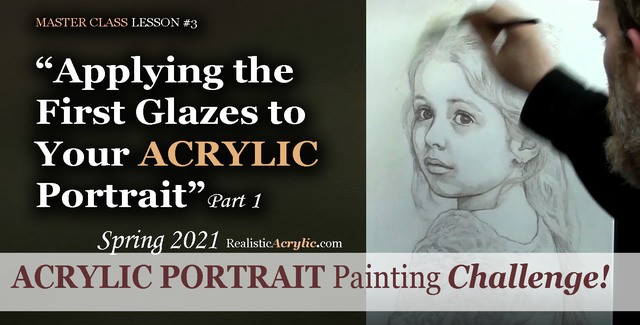
Learn to paint a realistic acrylic portrait using the classical glazing technique in this free online class. Lesson 3: Beginning the painting process–sealing in the sketch, whiting
Applying the First Glazes to Your Acrylic Portrait, Part 2
Let’s begin the actual painting process! I’ll show you what colors we are using, how to block in the value structure simply with just two colors and matte medium. We’re going to go light and leave room to correct any mistakes. This will be the foundation we’ll build off of from here on out…
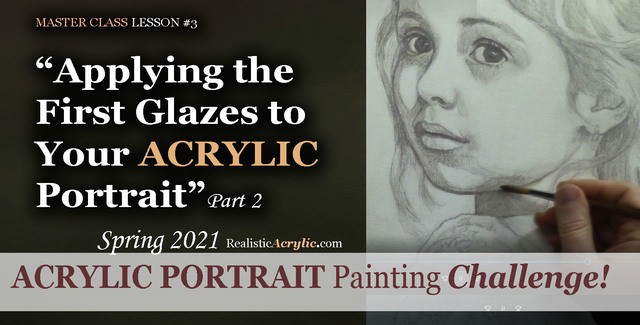
Learn to paint a realistic acrylic portrait using the classical glazing technique in this free online class. Lesson 3: Beginning the painting process
Would like to paint this portrait with me and hundreds of other artists?
Take the 2021 Spring Portrait Painting Challenge!
You can register below and get started. It is completely FREE to join the challenge and participate. When you join, I’ll send you the “Welcome Kit” which includes:
- The Supplies List (so you know what you need to paint with us, your shopping list. 🙂 )
- The Reference Photo with and without the grid, high resolution, that you can download ready to print out or display on your tablet. You’ll be able to create an accurate portrait this way.
- The Palette Layout Guide showing you how to arrange your colors so they don’t get muddy on your palette
- The Master Class Lesson Schedule
- the Lessons emailed to you
- A private Facebook group to cheer you and help answer your questions
- And a few “bonuses” like opportunities to win my paid online classes
REGISTER TODAY. The challenge is ongoing, something you can do at your own pace. It’s not too late to enter!
Let me know if you have any questions and I look forward to teaching you more!
—Matt
Questions? Suggestions? Thoughts? Let me know, below in the comments. Please share your sketches in our Facebook group and share this post with your friends!
